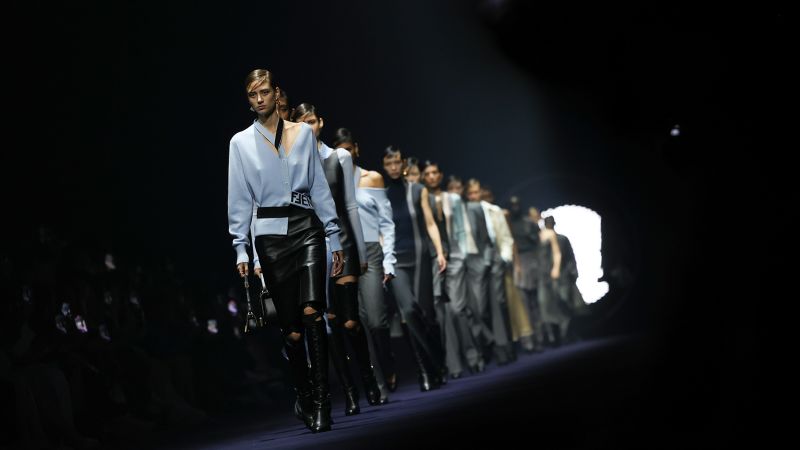Highlights;
-
The 2023 Fall-Winter fashion shows saw a significant decline in the presence of plus-size models, marking a reversal of recent progress in body diversity. Notable fashion houses like Fendi and Valentino featured fewer curve models, with a 24% drop in mid and plus-size models compared to the previous season.
-
The rise of injectable weight loss medications such as Wegovy and Ozempic, originally intended for medical conditions, has popularized rapid weight loss, influencing the fashion industry’s retreat from inclusivity and reviving the “size zero” ideal.
-
Industry insiders express frustration, highlighting the contradiction of brands using plus-size models for marketing while excluding them from runways, underscoring a lack of genuine commitment to diversity.
-
Smaller, progressive brands like Esther Manas and Collina Strada are leading the way in size inclusivity, showcasing diverse body types and challenging the status quo.
-
Systemic issues persist, with sample sizes typically limited to very small sizes, creating practical barriers for including larger models and leading to embarrassing and exclusionary experiences for some models.
-
Calls for systemic change emphasize the need for industry-wide standards, urged by fashion councils and media, to ensure diverse samples and promote inclusivity, though progress remains slow.
-
The growing use of weight loss drugs for cosmetic reasons raises health concerns and may deter further inclusivity efforts, highlighting the need for a more balanced approach to beauty standards.
The Vanishing Curve: Body Diversity and the Rise of Weight Loss Medications in Fashion
A Stark Contrasts on the Runways
The Fall-Winter 2023 fashion season revealed a troubling trend: a significant drop in the presence of plus-size models on runways across New York, London, Milan, and Paris. This regression comes at a time when weight loss medications, such as Wegovy and Ozempic, are gaining traction, particularly among Hollywood elite, stirring debates about body image and inclusivity.
The Rise of Weight Loss Medications
In the U.S., five injectable appetite suppressants are now available by prescription, with a sixth, Rybelsus, available in oral form. The U.K. has approved two such medications, marking the largest influx in a decade. These drugs, initially developed for conditions like Type 2 diabetes and obesity, have become synonymous with rapid weight loss, with celebrities like Chelsea Handler and Elon Musk openly discussing their use. However, their rise has raised concerns about accessibility, misuse, and potential side effects.
A Step Backward for Size Inclusivity
After years of gradual progress, the Fall-Winter 2023 runways saw a 24% drop in mid and plus-size models compared to the previous season. According to a Vogue Business report, 95.6% of all looks were in sizes 0-4, despite the fact that 68% of American women wear size 14 or above. Brands like Fendi, Valentino, and Erdem, which had previously embraced size diversity, were notably absent in their representation this season. When contacted by CNN, these brands declined to comment.
Challenges in Inclusivity
Model agent Mina White, who represents curve supermodels like Paloma Elsesser and Ashley Graham, described the situation as a “definitive backslide.” She emphasized the frustration of seeing brands leverage plus-size influencers for marketing while excluding them from runways. Stylist Francesca Burns highlighted the systemic issue of sample sizes, recounting a harrowing experience where a size 8 model couldn’t fit into clothes provided by Celine. “The desire to see change has to be there,” Burns said. “I wonder whether luxury has that desire?”
Small Steps Forward
While many brands regressed, a few stood out for their commitment to size diversity. Emerging labels like Di Petsa and Esther Manas featured size-diverse models, as did larger brands like Christian Siriano and Coach. British Vogue’s April issue celebrated curve models like Elsesser, Lee, and Jill Kortleve as “The New Supers,” but the disconnect between runway representation and consumer availability remained evident.
The Weight Loss Medication Debate
As weight loss drugs like Wegovy and Ozempic gain popularity, concerns about their misuse for aesthetic purposes grow. While these medications can be life-changing for those with medical needs, they are not without risks. Dr. Robert Lash, an endocrinologist, warned of side effects and the dangers of off-label use for individuals seeking to meet societal beauty standards.
A Call for Industry-Wide Change
Agents, advocates, and industry leaders are calling for systemic change. White emphasized the need for standardized sample sizes and inclusive practices, urging fashion powerhouses to take responsibility. “It shouldn’t be a conversation. It should just be normalized that we’re not just looking at a single view of beauty,” stylist Francesca Burns echoed.
The Future of Fashion
As the fashion industry grapples with representation and inclusivity, the rise of weight loss medications adds a new layer of complexity. With the pursuit of size zero now just a prescription away, the stakes are higher than ever. For White, Burns, and many others, the industry must take accountability and champion a more inclusive vision of beauty—one where every body is invited.


